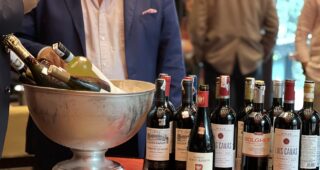
Last week ended on a heady note for me. As I received a call from Prarrthona Pal Chowdhury, Head Marketing, Brandy Project & International Brands at Sula Vineyards proposing a private tasting of Janus- their recently launched premium brandy- I agreed on it despite the short notice. Having already read about the Mumbai tastings of the brandy, I was eager to taste it at the earliest, and here was a ready opportunity.
But why was I so keen to taste an Indian brandy after having experienced many international brands of repute? Simply because Janus happens to be the first 100% grape brandy produced in India. Then what exactly are the rest? For that let us first try to understand brandy in the right perspective.
What is a brandy?
The word “brandy” originated from “brandewijn” – a Dutch term for burnt wine. In olden days when wine was being transported in barrels through the tardy sea route, there were frequent cases of spoilage owing to climatic variations and uncontrolled storage conditions. A workaround to this problem saw wine being distilled, dramatically improving the shelf life of this “burnt wine”, which was then consumed at the destination diluted with water.
But there is more to brandy than just “burning” wine. Evidence of its use in medicine over the centuries is aplenty. It has since then evolved as a refined alcoholic beverage, largely revolving around two aspects- Geographic Indication and Oak Ageing. Hence we know Cognac, Armagnac and other fine brandies the way they are.
The Brandy classification however applies to any fruit originated spirit and not just grapes. Hence we have Calvados (an apple brandy), Poire Williams (a pear brandy) and so on. But grape brandy has been most prevalent with its recognized high antioxidant and remedial properties. Probably the reason why the French coined the special term Eau de vie meaning “water of life” for this elixir.
Given this background, it becomes imperative that when we buy a brandy for its virtues, it should be a 100% grape spirit rather than a blend of other distillates. In the Indian context (also in majority of Asian region) the latter is quite common with even grain based spirits finding their way inside the blend . Hence the arrival of a home grown 100% grape brandy as Janus has come as a welcome development for connoisseurs of fine beverages in India.
The Blind Tasting
My tasting experience at Prarrthona’s behest involved three samples poured out of nondescript bottles with a simple premise- to discern the smoothest one and to guess which one could probably be Janus. The “simple” agenda though, had more to it as she further told me that samples other than Janus could be anything- whisky, rum, or another brandy. The task looked uphill but I decided to be patient and go over the samples in three iterations as follows:
- Ruling out by exception.
- Identifying typical traits of each sample.
- Confirming my findings through a rerun.

Here is how it went (my inferences shown in parentheses):
Iteration # 1 : Colour and Aromas only.
Sample 1: Light coloured with unmistakable malt notes amongst others. (most probably a whisky).
Sample 2: Glowing amber colour, a honeyed nose accompanied by citrus fruit aromas (undecided).
Sample 3: Deep gold with peaty nose (a scotch whisky for sure).
Iteration # 2 Aromas and Palate.
Sample 1: Malt notes confirmed with floral and sherry notes. (reasonably sure about whisky).
Sample 2: Sweet spice and floral notes with the smoothest finish of all (betting heavy on brandy)
Sample 3: Deep gold with peaty nose. Rich flavours but not so smooth (a whisky for sure)
Iteration # 3 Confirmation.
Sample 1: Earlier observations confirmed. (This is a whisky).
Sample 2: Most likely this is Janus.
Sample 3: Definitely a whisky.
As I conveyed my opinion to Prarrthona, she was delighted the same way as I was. For her, it was the vindication of confidence in her brand which she had so boldly pitted against other reputed ones. For me, it was a reassurance of my primal senses related to beverages appreciation.
Having known which one was Janus, I could now dwell leisurely to analyse it as a brandy. I found that apart from the smoothness it had a refined feel that was inclined towards the Cognac style replete with a full body and a fruity and spicy character.

Prarrthona told me that the Cognac orientation of Janus was a given since the product had started as a collaboration between Remy Cointreau and Sula. With the exit of Remy Cointreau from India as a business rehash and selling of their assets (including brandy stocks and equipment) to the Indian winemaker, Janus continues to be produced using the same equipment (pot stills, limousine oak barrels etc) that was specially imported from Remy’s facility in France. French Master Blender, Yonael Bernard has purposefully created a smooth and distinctive blend that carries the Cognac character with aplomb.
Currently Janus is available in Goa at ₹ 1500.00 / ₹ 395.00 for a 750 ml / 180 ml bottle. I am told that it will soon to be launched in Mumbai, Delhi and Bangalore followed by other cities pan India.
But isn’t it a marketing challenge to convince the average Indian consumer to buy a significantly higher priced brandy when there are lesser “brandies” that sell at nearly half the price? Prarrthona tells me that they see Janus as having no competition in the current brandy market owing to its entirely different niche. However, she acknowledges that they will have to conduct awareness campaigns to educate the consumer on this aspect.
In the meantime, I have found a perfect local companion for my “Sidecar”









